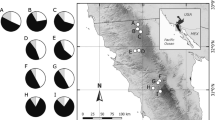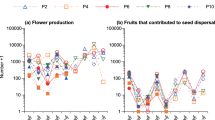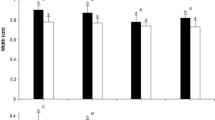Abstract
An increased understanding of intraspecific seed packaging (i.e. seed size/number strategy) variation across different environments may improve current knowledge of the ecological forces that drive seed evolution in plants. In particular, pre-dispersal seed predation may influence seed packaging strategies, triggering a reduction of the resources allocated to undamaged seeds within the preyed fruits. Assessing plant reactions to pre-dispersal seed predation is crucial to a better understanding of predation effects, but the response of plants to arthropod attacks remains unexplored. We have assessed the effect of cone predation on the size and viability of undamaged seeds in populations of Juniperus thurifera with contrasting seed packaging strategies, namely, North African populations with single-large-seeded cones and South European populations with multi-small-seeded cones. Our results show that the incidence of predation was lower on the single-large-seeded African cones than on the multi-small-seeded European ones. Seeds from non-preyed cones were also larger and had a higher germination success than uneaten seeds from preyed cones, but only in populations with multi-seeded cones and in cones attacked by Trisetacus sp., suggesting a differential plastic response to predation. It is possible that pre-dispersal seed predation has been a strong selective pressure in European populations with high cone predation rates, being a process which maintains multi-small-seeded cones and empty seeds as a strategy to save some seeds from predation. Conversely, pre-dispersal predation might not have a strong effect in the African populations with single-large-seeded cones characterized by seed germination and filling rates higher than those in the European populations. Our results indicate that differences in pre-dispersal seed predators and predation levels may affect both selection on and intraspecific variation in seed packaging.



Similar content being viewed by others
References
Adams RP (2008) Junipers of the world: the genus Juniperus, 2nd edn. Trafford Publishing, Vancouver
Adams RP, Thornburg D, Corbet M (2014) A survey of percent-filled and empty seeds in Juniperus of the western United States. Phytologia 96:2–12
Alcantara JM, Rey PJ (2003) Conflicting selection pressures on seed size: evolutionary ecology of fruit size in a bird-dispersed tree, Olea europaea. J Evol Biol 16:1168–1176. doi:10.1046/j.1420-9101.2003.00618.x
Amaral-Franco J (1986) Juniperus. In: Castroviejo S, Laínz M, López-González G et al (eds) Flora ibérica. Real Jardín Botánico, C.S.I.C., Madrid, pp 181–188
Bonal R, Muñoz A (2008) Seed growth suppression constrains the growth of seed parasites: premature acorn abscission reduces Curculio elephas larval size. Ecol Entomol 33:31–36. doi:10.1111/j.1365-2311.2007.00935.x
Bonal R, Muñoz A, Díaz M (2007) Satiation of predispersal seed predators: the importance of considering both plant and seed levels. Evol Ecol 21:367–380. doi:10.1007/s10682-006-9107-y
Boratyński A, Jasińska AK, Marcysiak K et al (2013) Morphological differentiation supports the genetic pattern of the geographic structure of Juniperus thurifera (Cupressaceae). Plant Syst Evol 299:773–784. doi:10.1007/s00606-013-0760-7
Bradford DF, Smith CC (1977) Seed predation and seed number in Scheelea palm fruits. Ecology 58:667–673
Carrión JS, Yll EI, Walker MJ et al (2003) Glacial refugia of temperate, Mediterranean and Ibero-North African flora in south-eastern Spain: new evidence from cave pollen at two Neanderthal sites. Glob Ecol Biogeogr 12:119–129
DeSoto L, Varino F, Andrade JP et al (2014) Different growth sensitivity to climate of the conifer Juniperus thurifera on both sides of the Mediterranean Sea. Int J Biometeorol 58:2095–2109. doi:10.1007/s00484-014-0811-y
El Alaoui El Fels MA, Roques A (2006) Les arthropodes associés aux galbules et aux graines des genévries autochtones dans la partie sud du Bassin Mediterranéen. In: García-González MD, Alifriqui M, Broto M et al (eds) Actas del III Coloquio Internacional sobre Sabinares y Enebrales (Gen. Juniperus): ecología y gestión forestal sostenible. Junta de Castilla y León, Soria, pp 437–445
Eriksson O (1999) Seed size variation and its effect on germination and seedling performance in the clonal herb Convallaria majalis. Acta Oecol 20:61–66. doi:10.1016/S1146-609X(99)80016-2
Escribano-Avila G, Sanz-Pérez V, Pías B et al (2012) Colonization of abandoned land by Juniperus thurifera is mediated by the interaction of a diverse dispersal assemblage and environmental heterogeneity. PLoS One 7:e46993. doi:10.1371/journal.pone.0046993
Farjon A (2005) A monograph of cupressaceae and sciadopitys. Royal Botanic Gardens, Kew
Fernandes GW, Whitham TG (1989) Selective fruit abscission by Juniperus monosperma as an induced defense against predators. Am Midl Nat 121:389–392. doi:10.2307/2426044
Fuentes M, Schupp EW (1998) Empty seeds reduce seed predation by birds in Juniperus osteosperma. Evol Ecol 12:823–827. doi:10.1023/A:1006594532392
García D (1998) Interaction between juniper Juniperus communis L. and its fruit pest insects: pest abundance, fruit characteristics and seed viability. Acta Oecol 19:517–525
García D, Zamora R, Gómez JM et al (2000) Geographical variation in seed production, predation and abortion in Juniperus communis throughout its range in Europe. J Ecol 88:436–446. doi:10.1046/j.1365-2745.2000.00459.x
García-González MD, De Peña M, De Pedro R, Verde N (2009) Estudio de viabilidad y tratamientos de germinación de semillas de Juniperus thurifera L. en tres localidades de la provincia de Soria. In: Navarro R, Zas R (eds) 5th Congr. For. Español. Montes y Soc. Saber qué hacer. SECF - Junta de Castilla y León, Avila, pp 1–9
Gauquelin T, Bertaudiere V, Montes N et al (1999) Endangered stands of thuriferous juniper in the western Mediterranean basin: ecological status, conservation and management. Biodivers Conserv 8:1479–1498
Geritz SAH (1998) Co-evolution of seed size and seed predation. Evol Ecol 12:891–911
Ghazoul J, Satake A (2009) Nonviable seed set enhances plant fitness: the sacrificial sibling hypothesis. Ecology 90:369–377. doi:10.1890/07-1436.1
Gómez JM (2004) Bigger is not always better: conflicting selective pressures on seed size in Quercus ilex. Evolution (N Y) 58:71–80
Gruwez R, Leroux O, De Frenne P et al (2013) Critical phases in the seed development of common juniper (Juniperus communis). Plant Biol 15:210–219. doi:10.1111/j.1438-8677.2012.00628.x
Guo H, Mazer SJ, Du G (2010) Geographic variation in seed mass within and among nine species of Pedicularis (Orobanchaceae): effects of elevation, plant size and seed number per fruit. J Ecol 98:1232–1242. doi:10.1111/j.1365-2745.2010.01688.x
Harper JL, Lovell PH, Moore KG (1970) The shapes and sizes of seeds. Annu Rev Ecol Syst 1:327–356
Herrera CM (1984) Selective pressures on fruit seediness: differential predation of fly larvae on the fruits of Berberis hispanica. Oikos 42:166–170
Janzen DH (1971) Seed predation by animals. Annu Rev Ecol Syst 2:465–492
Jordano P (1989) Pre-dispersal biology of Pistacia lentiscus (Anacardiaceae): cumulative effects on seed removal by birds. Oikos 55:375–386
Jordano P (1995) Frugivore-mediated selection on fruit and seeds: birds and St. Lucie’s cherry, Prunus mahaleb. Ecology 76:2627–2639
Knight RS (1987) Coping with seed parasitism: a possible response by Protasparagus aethiopicus. Oikos 48:15–22
Kolb A, Ehrlen J, Eriksson O (2007) Ecological and evolutionary consequences of spatial and temporal variation in pre-dispersal seed predation. Perspect Plant Ecol Evol Syst 9:79–100. doi:10.1016/j.ppees.2007.09.001
Leishman MR (2001) Does the seed size/number trade-off model determine plant community structure? An assessment of the model mechanisms and their generality. Oikos 2:294–302
Levey DJ (1987) Seed size and fruit-handling techniques of avian frugivores. Am Nat 129:471–485
Llorente R, Alonso R (2006) Influencia de la fauna conófaga y conoseminífaga en la capacidad reproductiva de Juniperus thurifera en Soria. In: García-González MD, Alifriqui M, Broto M et al. (eds) Actas del III Coloquio Internacional sobre Sabinares y Enebrales (Gen. Juniperus): Ecología y gestión forestal sostenible. Junta de Castilla y León, Soria, pp 447–454
Lord JM, Westoby M (2006) Accessory costs of seed production. Oecologia 150:310–317. doi:10.1007/s00442-006-0523-z
McCullagh P, Nelder JA (1989) Generalized linear models. Chapman & Hall, New York
Mehlman DW (1993) Seed size and seed packaging variation in Baptisia lanceolata (Fabaceae). Am J Bot 80:735–742
Meyer KM, Soldaat LL, Auge H, Thulke H-H (2014) Adaptive and selective seed abortion reveals complex conditional decision making in plants. Am Nat 183:376–383. doi:10.1086/675063
Mezquida ET, Olano JM (2013) What makes a good neighborhood? Interaction of spatial scale and fruit density in the predator satiation dynamics of a masting juniper tree. Oecologia 173:483–492. doi:10.1007/s00442-013-2631-x
Moegenburg SM (1996) Sabal palmetto seed size: causes of variation, choices of predators, and consequences for seedlings. Oecologia 106:539–543. doi:10.1007/BF00329713
Moles AT, Westoby M (2004) Seedling survival and seed size: a synthesis of the literature. J Ecol 351:372–383. doi:10.1111/j.0022-0477.2004.00884.x
Moles AT, Warton DI, Stevens RD, Westoby M (2004) Does a latitudinal gradient in seedling survival favour larger seeds in the tropics? Ecol Lett 7:911–914. doi:10.1111/j.1461-0248.2004.00647.x
Montesinos D, García-Fayos P, Verdú M (2010) Relictual distribution reaches the top: elevation constrains fertility and leaf longevity in Juniperus thurifera. Acta Oecol 36:120–125. doi:10.1016/j.actao.2009.10.010
Montesinos D, García-Fayos P, Verdú M (2012) Masting uncoupling: mast seeding does not follow all mast flowering episodes in a dioecious juniper tree. Oikos 121:1725–1736. doi:10.1111/j.1600-0706.2011.20399.x
Murray BR, Brown AHD, Dickman CR, Crowther MS (2004) Geographical gradients in seed mass in relation to climate. J Biogeogr 31:379–388. doi:10.1046/j.0305-0270.2003.00993.x
Nalepa CA, Grisselli EE (1993) Host seed size and adult size, emergence, and morphology of Megastigmus aculeatus nigroflavus (Hymenoptera : Torymidae). Environ Entomol 22:1313–1317
Obeso JR (2004) A hierarchical perspective in allocation to reproduction from whole plant to fruit and seed level. Perspect Plant Ecol Evol Syst 6:217–225. doi:10.1078/1433-8319-00080
Obeso JR, Martínez I, García D (2011) Seed size is heterogeneously distributed among destination habitats in animal dispersed plants. Basic Appl Ecol 12:134–140. doi:10.1016/j.baae.2011.01.003
Ortiz PL, Arista M, Talavera S (1998) Low reproductive success in two subspecies of Juniperus oxycedrus L. Int J Plant Sci 159:843. doi:10.1086/297605
Peco B, Traba J, Levassor C et al (2003) Seed size, shape and persistence in dry Mediterranean grass and scrublands. Seed Sci Res 13:87–95. doi:10.1079/SSR2002127
Quinn GP, Keough MJ (2002) Experimental design and data analysis for biologists. Cambridge University Press, Cambridge
Rouault G, Turgeon J, Candau J-N et al (2004) Oviposition strategies of conifer seed chalcids in relation to host phenology. Naturwissenschaften 91:472–480. doi:10.1007/s00114-004-0554-4
Sakai S, Harada Y (2007) Optimum size and number of seeds when seeds suffer pre-dispersal predation. Evol Ecol Res 9:599–617
Seltmann P, Leyer I, Renison D, Hensen I (2006) Variation of seed mass and its effects on germination in Polylepis australis: implications for seed collection. New For 33:171–181. doi:10.1007/s11056-006-9021-8
Stephenson AG (1981) Flower and fruit abortion: proximate causes and ultimate functions. Annu Rev Ecol Syst 12:253–279
Stowe KA, Marquis RJ, Hochwender CG, Simms EL (2000) The evolutionary ecology of tolerance to consumer damage. Annu Rev Ecol Syst 31:565–595
Teixeira H, Rodríguez-Echeverría S, Nabais C (2014) Genetic diversity and differentiation of Juniperus thurifera in Spain and Morocco as determined by SSR. PLoS One 9:e88996. doi:10.1371/journal.pone.0088996
Thompson JN (2005) The geographic mosaic of coevolution. University of Chicago Press, Chicago
Traveset A (1993) Deceptive fruits reduce seed predation by insects in Pistacia terebinthus L. (Anacardiaceae). Evol Ecol 5:187–361. doi:10.1007/BF01237867
Turgeon JJ, Roques A, Groot P De (1994) Insect fauna of coniferous seed cones: diversity, host plant interactions, and management. Annu Rev Entomol 39:179–212
Verdú M, García-Fayos P (1998) Ecological causes, function, and evolution of abortion and parthenocarpy in Pistacia lentiscus (Anacardiaceae). Can J Bot 76:134–141. doi:10.1139/cjb-76-1-134
Von Aderkas P, Rouault G, Wagner R et al (2005) Seed parasitism redirects ovule development in Douglas fir. Proc Biol Sci 272:1491–1496. doi:10.1098/rspb.2005.3061
Willson MF, Michaels HJ, Bertin RI et al (1990) Intraspecific variation in seed packaging. Am Midl Nat 123:179. doi:10.2307/2425771
Acknowledgments
We are especially grateful to MD García-González for her valuable advice on nursery procedure and to R Heleno for the early review of the manuscript. We also thank D Caimel, M Esteve, L Lope and P Lorenzo for helping in the laboratory, and M Alifriqui for his help in the field work. The comments and suggestions of A Worley, KL Gross and three anonymous referees improved the manuscript.
Author contribution statement
LDS and RT originally formulated the idea. LDS, SRE and CN conceived and designed the experiments. LDS and DT performed the experiments. LDS analyzed the data. All the authors wrote the manuscript.
Author information
Authors and Affiliations
Corresponding author
Ethics declarations
Funding
This work was supported by Fundação para a Ciência e a Tecnologia (FCT) with the project MEDIATIC (PTDC/AAC-CLI/103361/2008). LDS and RT were supported by a postdoctoral fellowship from FCT (SFRH/BPD/70632/2010) and Spanish Ministry of Education (BVA 2010-0375) respectively.
Conflict of interest
The authors declare that they have no conflict of interest.
Ethical approval statement
This article does not contain any studies with human participants or animals performed by any of the authors.
Legal statement
The experiments comply with the current laws of Portugal in which the experiments were performed.
Additional information
Communicated by Anne Worley.
Electronic supplementary material
Below is the link to the electronic supplementary material.
Rights and permissions
About this article
Cite this article
DeSoto, L., Tutor, D., Torices, R. et al. Pre-dispersal predation effect on seed packaging strategies and seed viability. Oecologia 180, 91–102 (2016). https://doi.org/10.1007/s00442-015-3446-8
Received:
Accepted:
Published:
Issue Date:
DOI: https://doi.org/10.1007/s00442-015-3446-8




